Most modern homes take advantage of the benefits of updated manufacturing and materials, containing fiberglass or acrylic bathtubs rather than traditional porcelain-coated cast iron or stainless steel. Affordable, attractive, and durable, fiberglass is nevertheless prone to cracking and pitting overtime.
Fortunately, repairing a cracked or damaged tub or shower pan is a straightforward DIY job that most homeowners can do to save themselves money over an expensive replacement. The cost to hire a professional to fix problems may prove worth the minor investment to ensure the cause of the issue is addressed to prevent future problems.
This guide covers the basics for fixing all shower floors, including bases and pans, but it mainly focuses on the most common issue – fiberglass tub repair.
This project costs an average of $20 to $240, depending on the extent of repairs needed and whether you hire a professional or handle fixing the damage on your own. Minor damage often only requires an epoxy kit, available at most home improvement stores. More extensive cracks and chips may require drywall mud, special two-component foam, and patches. Even at the high end, repairing is considerably less expensive than installing a new tub, and it usually only takes four to six hours including drying time.
On This Page:
- Repairing a Fiberglass Tub
- Repairing a Fiberglass Shower Pan
- Care & Maintenance Tips
- Acrylic Tub & Shower
- Fixing a Tile Pan
- DIY vs. Hiring a Pro
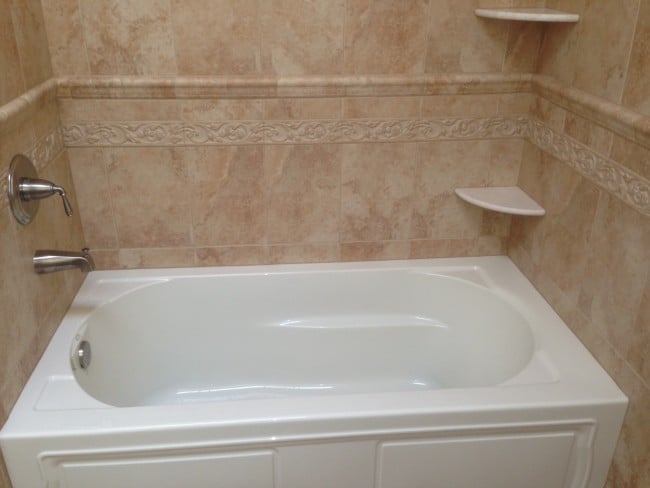
Repairing a Fiberglass Tub
No matter how bad a crack or an indentation may look, the process is the same as if it was a little pit. In either case, it’s surprisingly simple. By using a basic epoxy kit with a few essential items, repairing a fiberglass tub takes as little as one day, with most of that time spent as the compound dries.
Materials and Tools Needed
In general, this project requires minimal tools. For starters, you’ll need household cleaner and a sponge to clean the area before getting started. Additionally, you’ll need:
- Protective gear (goggles, respirator or mask and gloves)
- Rotary tool
- Drill
- 80-grit sanding paper
- Fine grit sanding paper
- Cellophane tape
- Two-component foam
- Fiberglass mesh/cloth
- Fiberglass repair kit
What Type of Repair? Crack, Chip or Hole?
Assessing the damage is the first step to determining the type of repair needed. Over time, heavy use can leave fiberglass, acrylic and other tub and shower materials vulnerable to cracking and chipping. Additionally, if something heavy drops on the surface, it could leave a large crack or a substantial hole, especially if the base isn’t properly supported.
Superficial chips, cracks and scratches may only require simple filling and refinishing. But for large ones, a professional should address the potential underlying problem and add extra support to the structure before patching and refinishing the base.
What to Look for in a Bathtub Repair Kit
To make your repair simple and stress-free, look for an all-inclusive kit that has everything you need to fix most issues. Minimally, kits include:
- Polyester resin/epoxy in putty or paste form
- Liquid hardener
- Mixing stick and tray or mat
- Sandpaper of various grits
- Protective gloves
- Colorants for common tub hues (i.e. almond, off-white), if needed
- Finishing polish
For larger cracks and pits, it may also be necessary to purchase fiberglass mesh to reinforce the putty and make it less likely to dimple. As a rule, use mesh for any crack wider than a quarter-inch or an open hole that is too large to fill in with the resin mixture alone. More extensive problems caused by improper installation and support may require drilling shallow holes in the tub, filling those holes with two-component foam, and adding fiberglass patches before using a refinishing kit.
Step-by-Step Guide
Filling a small hole or crack in fiberglass is a simple process, but you should set aside a whole day to allow time for the mixture to harden between steps. For this reason, this is a good job to begin in the morning and complete throughout the day between other home improvement projects. Repairs are similar for acrylic tubs, but we’ll cover the differences between the two processes below.
-
- Prepare the Area – Before getting started, clean the area with household cleaner and a sponge. Use rubbing alcohol, acetone, or a similar solvent capable of removing oils, soap scum, and glass fibers.
-
- Drill as Needed – When a lack of support is the root of the problem, you need to address the issue head on. Instead of removing the tub and rebuilding the support system, drill six to eight small holes in the tub and add foam (see next step). If you aren’t working on the underlying support, but you’re repairing a crack, use a rotary tool with 80-grit sand paper to grind a bevel that’s about 1 1/2 inches wide centered on the crack.
-
- Add Two-Component Foam – For extra support, inject two-component foam into the holes that you drilled. It sets in a few minutes and creates a strong foundation.
-
- Apply a Patch – If using fiberglass mesh, lay it over the crack or hole to measure, and then trim it so that it is slightly larger than the opening it is to cover. More than one layer may be necessary for especially deep holes.
-
- Mix the Filler – While wearing protective gloves, mix the resin putty and hardener as directed by your repair kit, adding colorant if working with a non-white tub. Use the provided mixing stick and tray and put it atop a piece of scrap cardboard to prevent accidental spills onto porous bathroom surfaces.
-
- Repair the Crack, Chip or Hole – Immediately spread the mixture into the crack or hole, or on top of the fiberglass mesh. Take care to work it in thoroughly to get it into all crevices and prevent dimpling. Don’t be afraid to pile the mixture atop the hole to fill it in completely; you will be sanding it later.
-
- Allow the Mixture to Set – Allow the mixture to set up in the hole for 2-3 hours or longer for larger, deeper holes. Once set, use the sandpaper to carefully smooth the surface. This might take some time and elbow grease.
- Refinish the Surface – Use the finishing polish to complete the patch and help the new area blend into the tub.
Ready to start your Tub or Shower Pan Repairs?
Find ProsReturn to Top
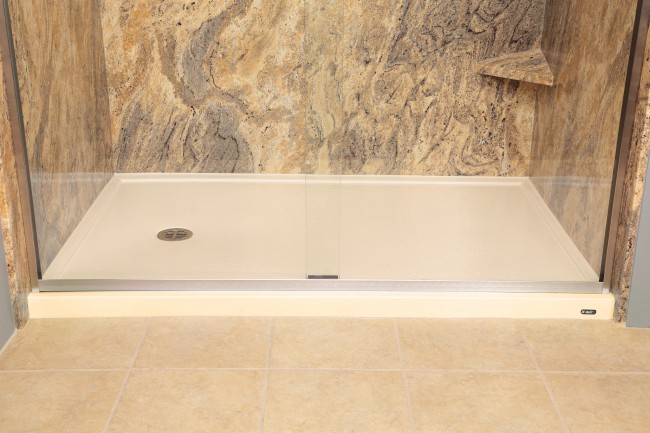
Repairing a Fiberglass Shower Pan
If you’re repairing the floor of a fiberglass stall, the method you use to complete a patch is no different than in a larger tub. However, because most of the surface of the base is horizontal and flat, it is possible to fix and reinforce larger holes and pits with scrap plywood in addition to epoxy, but only if you have access to the back or bottom of the pan. Some quick steps are:
- Spread epoxy on the plywood and press it onto the crack, from the unexposed side of the pan, to seal it.
- Apply the upper layer of epoxy on the exposed surface and sand it down.
Fiberglass Tub Care and Maintenance Tips
Like most home fixtures, when it comes to extending the life of your tub, preventing problems is the best solution. Your first line of defense it regular cleaning with the right type of cleaner and methods. This material responds best to mild soap, like dish soap, or even just a paste of baking soda and water. This is because the coating is thin and subject to wear over time. For this same reason, it is important to never use abrasive cleaners on these fixtures.
To maintain the luster of a single- or double-piece fiberglass tub, you might also consider giving it a regular polishing using automotive finishing products designed for fiberglass. Avoid using waxing products on this type of floor as this poses a safety risk when the shower is in use.
Ready to start your Tub or Shower Pan Repairs?
Find ProsReturn to Top
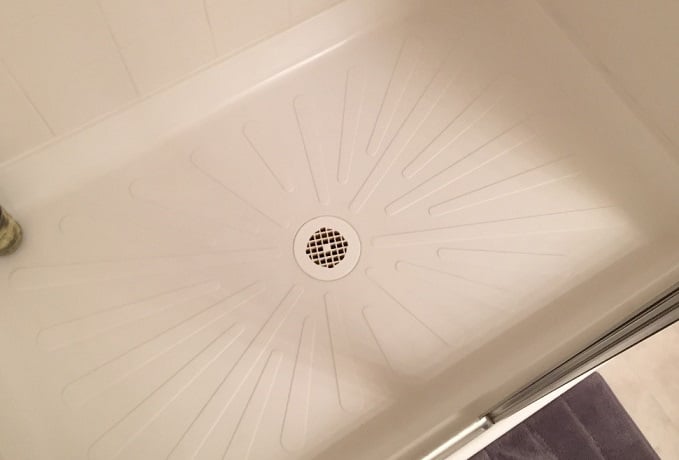
Acrylic Tub & Shower Repair
Acrylic is another commonly used material that can often be repaired instead of replaced. The steps are similar, but slightly different.
-
- Drill 1/4-inch holes in a 1-foot square around the damage, being careful to avoid drilling all the way through.
-
- Fill the holes with insulating foam to halt the acrylic from flexing after you’ve repaired the crack. Remove any foam leaking from the holes with a craft knife before sanding over the dried foam with a 240-grade sandpaper.
-
- Drill holes at either end of the crack, avoiding drilling through the acrylic.
-
- Use a two-part polyester filler to repair the damage, spreading it evenly over the drill holes and the crack with a rubber spreader.
-
- Once the filler is dry, sand it smooth and level with the rest of the tub’s surface.
-
- Wipe over the area with denatured alcohol to remove any dust.
- Apply bathtub repair paint to create a smooth, well-matched surface. Once the paint dries, add a final layer of urethane compound, and buff the area to create a smooth, hard finish.
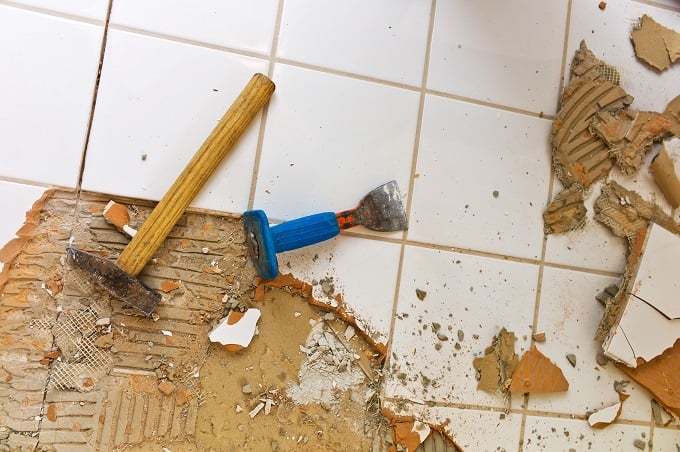
How to Repair a Tile Shower Floor
If the crack is minor, you may be able to repair it without incurring the cost of retiling the area. Otherwise, you’ll need to remove the damaged tiles and replace them before re-grouting.
Tools & Materials Needed
- Grout saw
- Drill with a masonry bit
- Chisel
- Scraper
- Notched trowel
- Tile adhesive or thinset
- Grout
- Sponge/rags
Step-by-Step Guide
When removing the tile,
-
- Use a grout saw to remove the grout surrounding the affected tile/tiles.
-
- Drill a hole through the center of the damaged tile, or several holes in a large tile.
-
- Break the tile into small pieces using the chisel, and use the scraper to remove them along with the thinset or tile adhesive behind the damaged tile.
-
- Apply a fresh coat of thinset or tile adhesive with a notched trowel or a putty knife if you’re working in a small area.
-
- Press the new tile in place and let the adhesive dry before grouting over the repair.
- Use a damp sponge to remove excess grout from the tile. Allow the grout to cure before using the shower.
When repairing the tile for a minor chip or crack,
-
- Clean the area with a mixture of oxygen bleach powder and water.
-
- Apply epoxy glue over the area to level it with the rest of the tile.
-
- Paint over the repair with a porcelain touch up kit to match it to the undamaged tile.
-
- Let the paint dry and add a coat of clear urethane.
- Once everything is dry, wipe over the area with a damp cloth.
Ready to start your Tub or Shower Pan Repairs?
Find ProsReturn to Top
DIY Considerations
Depending on the extent of the damage, this is a simple DIY project. If you decide to DIY this fix, make sure you allow yourself plenty of time to let the epoxy and other materials used in the repair dry between steps. Additionally, consider covering the area beyond the surface you’re working on with cellophane tape to prevent the refinishing materials from running over the intact part of the tub or shower pan.
If you suspect that the crack or hole has created water damage in the subfloor, or if the project feels like it’s more than you want to take on, hire a pro to do the work for you.
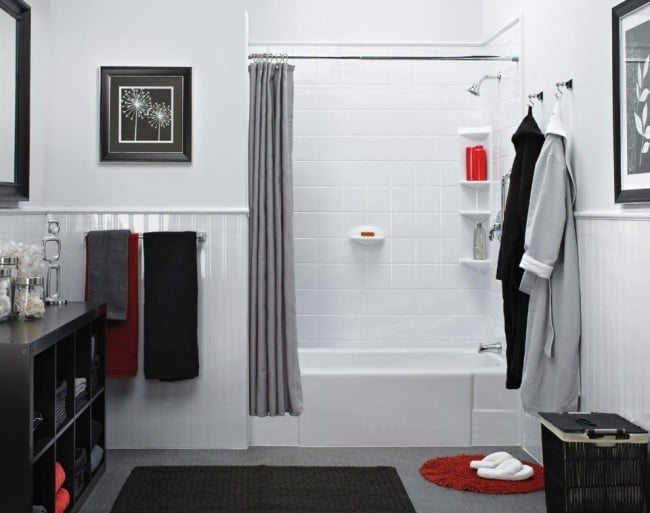
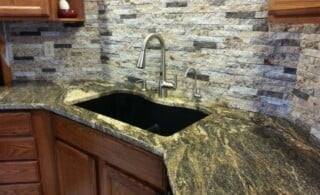 Corner Bathroom and Kitchen Sinks
Corner Bathroom and Kitchen Sinks 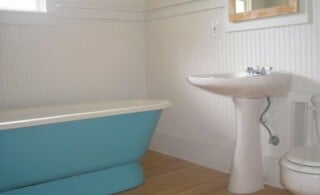 Pedestal Sinks Create an Elegant Space
Pedestal Sinks Create an Elegant Space 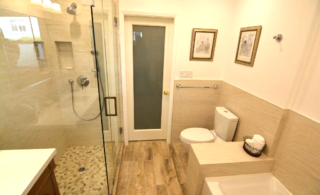 How Up Flush Toilets Work
How Up Flush Toilets Work 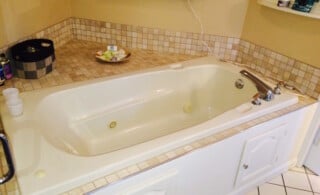 What to do with an Old Bathtub
What to do with an Old Bathtub  The Bidet Toilet
The Bidet Toilet 

When stepping into my shower, I hear a sound coming from beneath my feet, like a ‘popping sound’. There are no cracks in the shower floor whatsoever. What could be the problem and how do I get it fixed. The shower floor is fiberglass and is 17 years old….
Looking for local contractor that does fiberglass relining
Hi Vince
Follow the instructions on this link and local pros will be in touch to help. https://www.homeadvisor.com/task.Replace-Install-Bathtub.46477.html
The article says: “When a lack of support is the root of the problem, you need to address the issue head on. Instead of removing the tub and rebuilding the support system, drill six to eight small holes in the tub.”
And…? Is there a sentence missing here? What do I do after I drill the holes? How does this address the lack of support?
I have the same problem as Adrienne! Did you ever find out what it was?